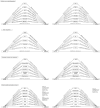Phthalate and gallstones: the mediation of insulin
- PMID: 38903577
- PMCID: PMC11188473
- DOI: 10.3389/fpubh.2024.1401420
Phthalate and gallstones: the mediation of insulin
Abstract
Background: Exposure to a mixture of environmental chemicals may cause gallstone, but the evidence remains equivocal. The current study aims to investigate the association between phthalate metabolites and gallstones, and to explore their mediators.
Methods: Data from the National Health and Nutrition Examination Survey 2017-2018 on U.S. adults (≥20 years) were analyzed to explore the association between phthalate metabolites and gallstones by employed survey-weighted logistic regression, restricted cubic spline (RCS), weighted quantile sum (WQS) regression, and Bayesian kernel machine regression (BKMR). Mediation analyses examined the role of oxidative stress markers, inflammatory markers, metabolic syndrome, body composition, diabetes, and insulin.
Results: The current study included 1,384 participants, representing 200.6 million U.S. adults. Our results indicated a significant association between phthalate metabolites, particularly high molecular weight metabolites such as Di(2-ethylhexyl) phthalate (DEHP) and 1,2-Cyclohexane dicarboxylic acid diisononyl ester (DINCH), and gallstones. Furthermore, mediation analyses indicated that phthalate metabolites may play a role in the development of gallstones by influencing insulin secretion. Subgroup analyses did not reveal significant interaction.
Conclusion: The association between exposure to phthalates and the occurrence of gallstones, potentially mediated by hyperinsulinemia from a nationally representative epidemiological perspective. These insights contribute to a better understanding of the potential health implications of plasticizers, emphasizing the need for proactive management measures.
Keywords: NHANES; cholelithiasis; hyperinsulinemia; mediation; plasticizer.
Copyright © 2024 Tang, Zhang, Huang, Luo, Chen, Yang, Lin and Hua.
Conflict of interest statement
The authors declare that the research was conducted in the absence of any commercial or financial relationships that could be construed as a potential conflict of interest.
Figures




Similar articles
-
Urinary phthalate metabolites associated with increased prevalence of gallstone disease in U.S. adults: data from the NHANES study.BMC Public Health. 2025 Jan 20;25(1):231. doi: 10.1186/s12889-025-21417-z. BMC Public Health. 2025. PMID: 39833743 Free PMC article.
-
Associations of phthalate and phthalate alternative metabolites in urine with the risk of gallstones in adults: a cross-sectional analysis.Environ Geochem Health. 2025 Jan 6;47(2):41. doi: 10.1007/s10653-024-02354-z. Environ Geochem Health. 2025. PMID: 39760927
-
Associations between phthalate metabolites and two novel systemic inflammatory indexes: a cross-sectional analysis of NHANES data.Ann Med. 2025 Dec;57(1):2496411. doi: 10.1080/07853890.2025.2496411. Epub 2025 Apr 24. Ann Med. 2025. PMID: 40272105 Free PMC article.
-
Phthalates mixture on allergies and oxidative stress biomarkers among children: The Hokkaido study.Environ Int. 2022 Feb;160:107083. doi: 10.1016/j.envint.2022.107083. Epub 2022 Jan 17. Environ Int. 2022. PMID: 35051840
-
Association between exposure to a mixture of phenols, pesticides, and phthalates and obesity: Comparison of three statistical models.Environ Int. 2019 Feb;123:325-336. doi: 10.1016/j.envint.2018.11.076. Epub 2018 Dec 14. Environ Int. 2019. PMID: 30557812
Cited by
-
Association of arm circumference with the prevalence of gallstones in United States adults: a retrospective analysis on US National Health and Nutrition Examination Survey.Front Med (Lausanne). 2025 Jan 24;12:1511637. doi: 10.3389/fmed.2025.1511637. eCollection 2025. Front Med (Lausanne). 2025. PMID: 39926432 Free PMC article.
-
The mediating role of circulating inflammatory cytokines in causal associations between plasma metabolites and asymptomatic bile duct and cholecyst calculus: A Mendelian randomization study.Medicine (Baltimore). 2025 Mar 7;104(10):e41745. doi: 10.1097/MD.0000000000041745. Medicine (Baltimore). 2025. PMID: 40068083 Free PMC article.
-
The global burden and biomarkers of cardiovascular disease attributable to ambient particulate matter pollution.J Transl Med. 2025 Mar 22;23(1):359. doi: 10.1186/s12967-025-06375-9. J Transl Med. 2025. PMID: 40121471 Free PMC article.
References
MeSH terms
Substances
LinkOut - more resources
Full Text Sources
Medical

